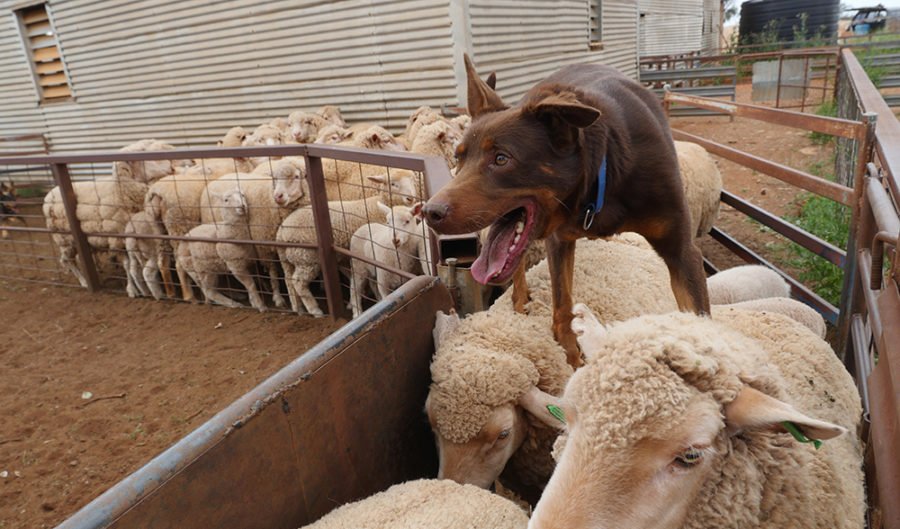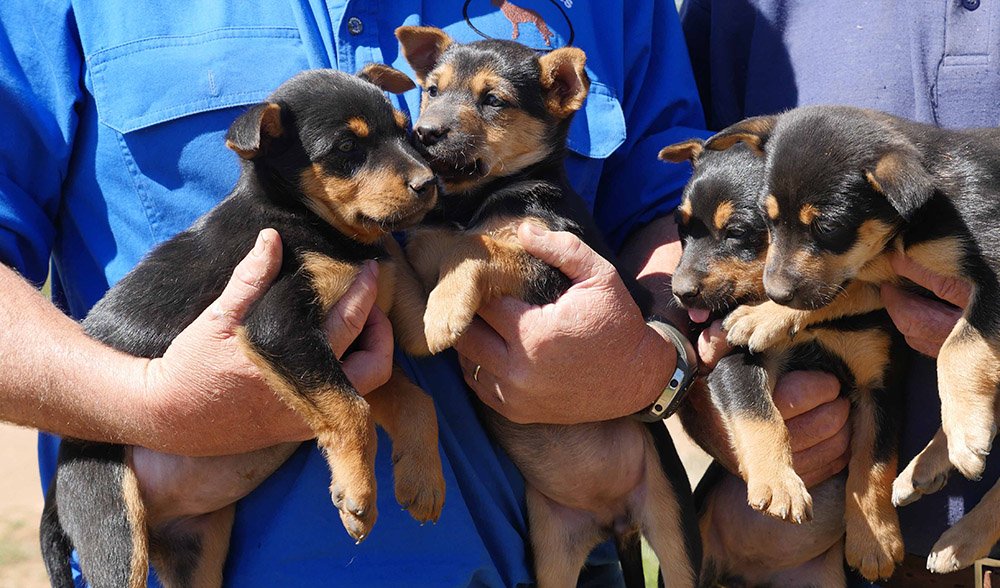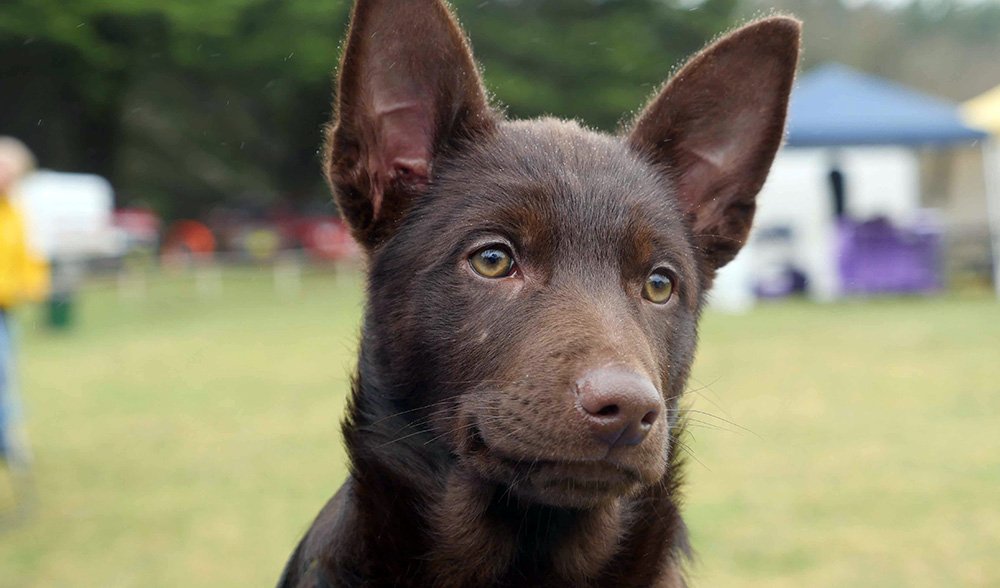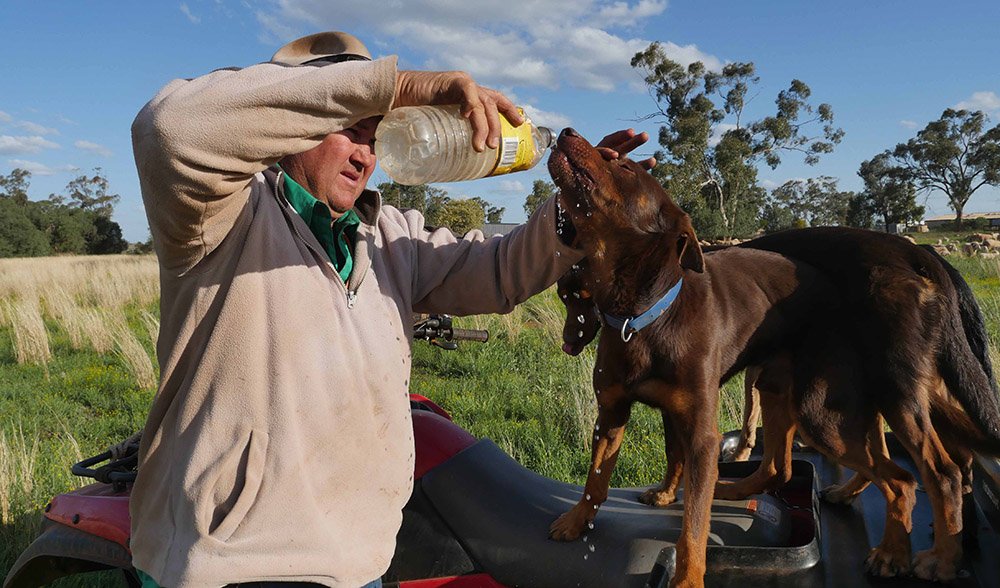Kelpie, king of the mob

IT’S JUST AFTER 7am on a sheep station near Nyngan, NSW, as Gary White, a famed stockman, mounts his all-terrain quad motorbike and revs its engine. He’s about to muster 1000 sheep and their lambs from several paddocks, up to 10km away.
Leaping onto the steel tray mounted on the back of the quad, three kelpies crouch – lithe, lean and muscled with piercing eyes – for the ride out to the paddocks. They shiver with the excitement of knowing they will soon be among the sheep to chivvy them to the station yards with unparalleled skill.
“We breed the kelpies for work with sheep, cattle and goats in tough conditions and it’s their greatest pleasure,” Gary says.
SEE ALSO: Australia’s top 10 most popular dog breeds
Among these three is Fella, Australia’s top kelpie sheepdog. He proved it by winning the National Kelpie Field Trial Championship in 2012 and 2014, taking on the best from
across the country. (He missed 2013 because Gary was abroad when the trials were held.)
I’m also riding a quad, and kangaroos bound out of the way as we roar along dusty red tracks and over bumpy fields, heading for the first paddock. Tall stringy eucalypts frame the fields beneath a brightening blue sky. When we reach the paddock, no sheep are in sight. Gary’s eyes tighten against the sun as he peers across the field. “Sheep prefer to graze into the breeze and so they will be somewhere over there,” he says, pointing to a timber stand about 400m away. “It’s going to be a long day so let’s go find them and get started.”

Born to work. John and Gary White show off the latest litter of their prize-winning kelpie pups.
MANY AUSTRALIANS BELIEVE kelpies emerged as a breed after British collie sheepdogs were bred with Australia’s dingoes. Not so, says Barbara Cooper, the registrar of the Working Kelpie Council of Australia, based in Sydney. Although there is a physical resemblance between kelpies and dingoes – their sharp faces, colouring and high, pointed ears – the first kelpies were bred in the 1870s by crossing strains of collie sheepdogs imported from Scotland by rural landholders in NSW.
It’s thought the original female, a black-and-tan working collie named Kelpie, was born on a station on Glenelg River, Victoria, and trained by a stockman named Jack Gleeson. The dog’s initial lines of offspring were known as Kelpie’s pups, and then simply as kelpies, after the breed expanded. “They bred them to handle the harsh local conditions,” Barbara says.
Veterinarian Dr Clive Ogilvie, based in the Dandenong Ranges on the outskirts of Melbourne, says kelpies evolved from that foundation stock to have “athletic, agile bodies, straight legs, strong hearts and good lung capacity. They have long [snouts] for ease of breathing and efficient heat loss through panting; and small, well-set eyes to avoid injuries.”
Gary says kelpies are much better suited to rugged outback conditions than border collies. “It can get very hot out here during summer, often above 38ºC. The kelpies handle the extreme heat and the long distances that they sometimes have to muster with ease, going for hours without water. Their short hair handles burrs better than the long-haired collies’ [coats].”
SEE ALSO: GALLERY: Australian working dogs
Kelpies are also highly intelligent, a trait of other collie-based breeds. Gary’s 82-year-old father, John, a former sheep-station manager, has bred top-class kelpies for half a century. He says the best working dogs have to be able to act on their own initiative.
“In the event of wild, unpredictable sheep, a dog retaining his own initiative reacts instantly through inborn anticipation of what the sheep are going to do. In general farm work with sheep, a dog unable to carry out the tasks without constant commanding is more of a liability than an asset,” he says.
Veterinarian Dr Elizabeth Arnott, from Quirindi in western NSW, is devoting several years to studying the genetics of the best kelpie working dogs at the University of Sydney’s veterinary faculty, in an effort to improve the overall attributes of the breed. She says there are up to 300,000 dogs working with livestock in the bush and about 60 per cent are kelpies.
She has taken blood samples from Fella (Whites Fella II) and other top working kelpies to determine, by their DNA, what makes them such good working dogs. “Farmers are telling us that about 20 per cent of the working kelpies are no good; they lack the natural herding instincts of the best kelpies,” Liz says.

Kelpies’ hypnotic stares can transfix a mob of rambunctious sheep and keep them in their place.
One of the most important traits is composure. It’s commonly believed that kelpies constantly nip at the sheep’s hooves to keep them moving on a muster – but that’s also a fallacy.
“The best kelpie working dogs like Fella have a calmness so they don’t stress the sheep,” Liz says. “They also know how close they can go to the sheep without scattering them, confident they can control them. The best also have boldness, intelligence, anticipation and initiative.”
Liz tells me kelpies are bred to have boundless energy and a compulsive desire to work. I witness this at an off-leash dog park in Sydney’s inner-west suburb of Leichhardt. Up to 100 dogs of many breeds are brought there each day. Kelpies are the most energetic, dashing about almost without stopping, even herding other dogs for no reason other than their natural instincts.
They are fun but tough work as pets. Ellen O’ Connor brings her kelpie, Aofie, to the park every afternoon, sometimes twice on a Saturday or Sunday, even when it’s raining and she and the handful of other kelpies and their owners are the only ones in the park. “Aofie needs to run daily or she can become disruptive. But the joy she gives me is worth it,” Ellen says.

Traditions change. Nowadays Gary musters with an all-terrain quad. He can do the work of four stockmen mounted on horses.
I SEE LITTLE EVIDENCE of that manic energy among the kelpie show dogs, the pretty boys and girls of the breed.
The sky is overcast as I arrive at a grassy oval in the hamlet of Berrima in the Southern Highlands of NSW. Several multi-coloured tents have been pitched on either side of a roped-off ring, like pavilions at medieval jousting contests. Inside, about 50 kelpies – Supreme, Grand and Australian champions – peer out from dog crates.
It’s one of the biannual gatherings in which the very best NSW kelpie show-dog breeders to compete for highly desired trophies and sashes including best kelpie in the show. Marie Colyer, queen of kelpie show-dog breeders, is meticulously grooming Australian champion Becky, whose stud name is Wingdari Dinki Di Oz. In April 2014 at the Sydney Royal Easter Show, the Royal Agricultural Society of NSW included Marie in the prestigious Parade of Champions, honouring her for the successes of her dogs at the show over the years.
At Berrima, Marie is attended by a group of acolytes, her kelpies’ handlers, who parade the dogs before the presiding judge, Joan Bray.
The tension among the top breeders crackles, and they rarely talk as their dogs go through their paces in the ring, watched closely by the judge. Clad in knee-high boots, Joan judges them on their physique, soundness and type, and how freely they move. Having worked with kelpies in the bush a few years earlier, I instantly notice the difference. The show dogs have handsome heads but their legs are shorter and their bodies considerably stouter.
“Kelpies not selected primarily for their working ability and stamina are unlikely to last a day on a sheep station,” Liz had told me. “They’re evolving as a separate breed.”
Marie proudly shows me Danny (Wingdari G’day Easy Goin’ Drover), a beautiful 12-week-old puppy. He has a lean, athletic look, but he will begin to resemble his elders within a year or two. Late in the day Marie scores yet another success with Wingdari Dinki Di Oz, who is judged Best Exhibit in Show.

Mustering sheep in the heat is tough work. Stockman Gary White takes bottles of water to refresh his kelpies.
A FEW DAYS LATER I head back to Nyngan, in the geographic heart of NSW, to see the very best kelpie working dogs. The town’s population is just more than 2000 and the region’s economy is largely based on sheep stations and farming. Social life revolves around the RSL club and strangers cheerily greet you on the street. It is an echo of an Australia that has mostly disappeared from our cities.
It’s Sunday morning and Gary White, Fella’s stockman owner, arrives at my motel. He is tall, wears work-worn jeans and a stetson, and is friendly and easygoing. He’s taking me to his father’s farm, 30km into the scrub. John White has retired but still breeds some of the best working kelpies – between two and four litters a year. Out here kangaroos and wedgies are many times more numerous than people and there are no other homesteads for several kilometres.
John takes me to an open pen where his latest litter – six beautiful black-and-tan puppies, just five weeks old – play with rough-and-tumble gusto. John carries a chunk of fluffy wool, attached to a stick by a string, and trails it along the ground to test which puppies have strong working instincts. “They will make the best working dogs,” he says.
Some pups ignore the wool, preferring to play. But a couple, with deadly wolf-like focus, crouch and follow the wool, competing for it. John smiles when one grabs it in his mouth.
In a nearby yard he keeps a few sheep, including a stocky ram, to train older pups. He lets in an experienced kelpie and a seven-month-old pup. The pup watches intently, like a diligent apprentice, as the master kelpie quickly pushes the sheep into a tightly packed bunch and backs them against a fence. When one breaks free the kelpie swiftly catches it – and when it turns on him and charges, he leaps up and headbutts it to force it back into the group.
When it’s the pup’s turn, dwarfed by the sheep, he rounds them up with impressive skill and pushes them into a corner of the yard. A bulky sheep turns on him, threatening to charge, but the pup stands his ground. Solely by his willpower and fierce stare, he forces it back into the huddled group.

A promising pup of seven months challenges a mob of full-grown sheep.
THE NEXT MORNING, AT 7AM, Gary arrives at the motel with six of his 17 dogs in the back of his vehicle. “It’s tough work so I rotate them,” he says.
As we head for Bel-Air station, massive road trains roar past us on the highway to Broken Hill. About 30km from town we turn onto a dusty track leading to the station.
There, grazier Mick Hoare lists the paddocks where he has kept the sheep to be mustered. Mick runs about 3000 ewes and their lambs on this and his two other stations – for a total of nearly 7000ha – as well as 50 rams to service all those ewes.
Mick keeps the ewes in mobs of about 300 in separate paddocks. Over the next three days, Gary and his kelpies will muster the ewes and lambs into the yards by the homestead so the lambs can be marked, castrated and ear-tagged.
The first paddock is 10km distant, and, once Gary and the kelpies spot the sheep by the timber stand, we drive the quads across the field. As we near the sheep the kelpies crouch, ready to leap into action. Fella is with them, sturdy and reddish-brown. He’d be laughed out of a kelpie show-dog trial but has an innate sense of dignity and confidence that mark him as a leader.
Nearing the sheep, Fella and another kelpie leap from the quad, hurtle into the timber stand and soon have all the sheep streaming out to the open paddock. Although working kelpies at times need to use their own initiative, Gary employs a series of whistles and shouted commands that guide the kelpies in their manoeuvring of the ewes and lambs into a bunched mob. Fella spots a small pack as they make a break for the trees and he is a blur as he races to round them up and herd them back.
Passing through the gate separating the paddocks, 20 lambs escape and run back to the trees. Gary and the kelpies give chase and it takes them another hour to bring the lambs back to the mob. Mick tells me later that it would have taken him most of the morning to achieve the same thing: “Gary and his dogs are the best musterers around,” he says.
Many of the lambs are only a few days old, and, well into the muster, one refuses to go any further. It stands its ground and shivers with exhaustion. Gary pulls up and gathers it into his arms, cradling it as he drives on.
At the yards, Fella and the two other kelpies herd the sheep into a race – a narrow outdoor passageway enclosed by steel bars – where the ewes are temporarily separated from the lambs. When there is a tangle or blockage of sheep at the top of the race, Fella races along their backs and untangles it. He gets kicked and banged many times against the steel bars but doesn’t flinch. “The kelpies are usually dead tired at the end of each day but they’re fresh and raring to go by the next morning,” Gary says.
The bleating of the separated ewes and lambs is deafening. Gary explains that each mother and its lamb have a distinctive call, so they can find one another in a mob. Once the lambs have been dealt with they run into the paddock and quickly find their mothers to huddle against their flanks.

Marie Colyer, one of the most successful breeders of show kelpies, cradles a champion young dog.
AS WE HAVE LUNCH Gary tells me he has the best job in the world, out in the open each day with his beloved kelpies. The record price for a working kelpie was $12,000 at Casterton, Victoria, in 2012 but Gary says he wouldn’t sell Fella for $20,000 or more.
He follows his father’s way in training them, not with fear of punishment but with love and affection. He also breeds kelpies and allows his pups their first 12 months to enjoy an easy life around his home before he begins to train them for stock work. On the second day at Bel-Air, he brings along Ruby, a one-year-old female.
Now and then she makes a mistake, such as rushing to the head of the mob, but swiftly runs to the back of the sheep to join Fella when Gary whistles. “I don’t mind her making mistakes because she’ll learn from them,” he says.
Even when Ruby dashes into the mob and wrestles a lamb to the ground without biting it, he doesn’t punish her. “It’s like a cat playing with a mouse,” he says, smiling, after he jumps off the quad and separates them.
Liz Arnott says it’s likely the kelpies’ importance has been increasing because competition for workers from the mining sector has made rural Australia more reliant on working dogs. So, for the moment, in an age of ever-increasing technology, the place of hardy, work-loving kelpies in the bush is secure.
This article was originally published in the Jan-Feb 2015 edition of Australian Geographic (AG#124).
RELATED:
- Australia’s 10 most popular dog breeds
- GALLERY: Tribute to Australian working dogs
- Dogs can detect emotions from facial expression
- Guard dogs: fur protecting feathers

